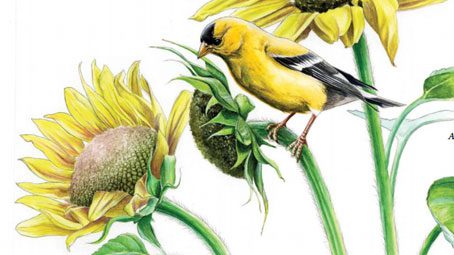The Best Trees, Vines, and Shrubs to Plant for Birds: a Starter List
April 20, 2015

These are some of our favorite plants and trees for birds—but they may not work for all regions. Planting native vegetation is always your best bet—check with a local native-plant nursery for help and advice.
Related Stories
Deciduous trees
Mulberries (Morus species)
- Season: Summer fruiting
- Description: Medium-sized trees, 30 to 60 feet high. Fallen fruit messy: avoid planting near sidewalks or car parking areas
- Food type: Fruit
- Attracts: Robins, waxwings, cardinals, numerous other songbirds
- Also provides: Nest sites
Serviceberries (Amelanchier species)
- Season: Summer fruiting
- Description: Medium-sized trees, 25 to 60 feet high. Produce masses of white or pinkish flowers in spring. Reddish berries in summer
- Food type: Fruit
- Attracts: Robins, waxwings, cardinals, vireos, tanagers, grosbeaks, others
- Also provides: Nest sites
Flowering dogwood (Cornus florida)
- Season: Fall fruiting
- Description: Excellent choice for birds and people. Well-known ornamental tree, to 40 feet high. Attractive white, pink, or red flowers in spring Scarlet berries in fall
- Food type: Fruit
- Attracts: Robins, bluebirds, thrushes, catbirds, cardinals, tanagers, grosbeaks, many others
- Also provides: Nest sites
Crabapples (Malus species)
- Season: Fall fruiting; winter-persistent fruits
- Description: Medium-sized trees, with attractive blossoms in spring. Choose a variety with small fruits (easier for birds to swallow)
- Food type: Flower buds, flowers, fruit, seeds
- Attracts: Robins, bluebirds, thrushes, catbirds, cardinals, waxwings, Pine Grosbeaks, finches, many others
- Also provides: Nest sites, cover
White oak (Quercus alba)
- Season: Fall fruiting; winter-persistent fruits
- Description: Large tree. Produces acorns every year, unlike other oaks
- Food type: Acorns
- Attracts: Woodpeckers, jays, Wild Turkeys, grouse, Wood Ducks, others
- Also provides: Nest sites, cover
Coniferous Trees
Eastern red cedar (Juniperus virginiana)
- Season: Fall fruiting, winter persistent fruit
- Description: Attractive cone-shaped tree, usually grows 50 to 90 feet tall. Fleshy, pale blue, berry-like cones borne on female trees only
- Food type: Fruit
- Attracts: Waxwings and others
- Also provides: Excellent nest sites and cover
Spruces (Picea species)
- Season: Fall fruiting, winter persistent fruit
- Description: Often large trees, may grow up to 150 feet tall.
- Food type: Seed-bearing cones. Its evergreen needles are a good source of insects in early spring.
- Attracts: Crossbills and other seed-eaters in fall and winter. Migrating warblers search for insects in spring.
- Also provides: Nest sites, cover
Vines
Wild grape (Vitis species)
- Season: Fall fruiting
- Description: Climbing vine that provides superb fruit, eaten by more than 50 species of birds. Dense greenery makes it a good hedgerow plant
- Food type: Fruit
- Attracts: Robins, bluebirds, thrushes, catbirds, cardinals, orioles, Wild Turkey, Pileated Woodpecker, mockingbirds, thrashers, many others.
- Also provides: Excellent nest sites, nest material (shredding bark), cover
Virginia creeper (Parthenocissus quinquefolia)
- Season: Fall fruiting, winter persistent fruit
- Description: Tree-climbing vine with brilliant scarlet foliage in autumn. Important food plant for many bird species
- Food type: Fruit
- Attracts: Robins, bluebirds, thrushes, catbirds, cardinals, starlings, Wild Turkey, vireos, warblers, Pileated Woodpecker, many others
- Also provides: Nest sites, cover
Shrubs
Northern bayberry (Myrica pensylvanica)
- Season: Fall fruiting, winter persistent fruits
- Description: Semi-evergreen shrub produces fragrant, waxy, silver-gray berries, which stay on the plant year-round
- Food type: Fruit
- Attracts: Tree Swallows (especially wintering), catbirds, bluebirds, many others.
- Also provides: Nest sites, cover
Staghorn sumac (Rhus typhina)
- Season: Fall fruiting, winter persistent fruits
- Description: Brilliant red foliage in fall. Spikey clusters of hairy red fruits
- Food type: Fruit, seeds
- Attracts: Robins, bluebirds, thrushes, catbirds, cardinals, chickadees, starlings, Wild Turkey, Pileated Woodpecker, many others
Red-osier dogwood, gray dogwood, and others (Cornus species)
- Deciduous shrub
- Season: Fall fruiting
- Description: Hardy shrub. Fruit with high fat content provides important food for migrating songbirds in fall
- Food type: Fruit
- Attracts: Robins, bluebirds, thrushes, catbirds, vireos, kingbirds, juncos, cardinals, warblers, Wild Turkey, grouse, others
- Also provides: Nest sites, cover
Nannyberry, arrowwood (Viburnum species)
- Season: Fall fruiting, some fruits are winter persistent
- Description: Large genus of easy-to-grow shrubs. White flowers in spring. Produces red, yellow, blue or black berries
- Food type: Fruit
- Attracts: Robins, bluebirds, thrushes, catbirds, cardinals, finches, waxwings, others
- Also provides: Nest sites, cover
Winterberry (holly) (Ilex verticillata)
- Deciduous shrub
- Season: Fall fruiting, winter persistent fruits
- Description: Hardy shrub, tolerant of wet conditions. Scarlet berries are important food for winter resident birds. Berries borne on female plants only—for best results plant group several female plants with at least one male plant (your nursery will label it as such)
- Food type: Fruit
- Attracts: Robins, bluebirds, waxwings, others.
- Also provides: Cover


All About Birds is a free resource
Available for everyone,
funded by donors like you











